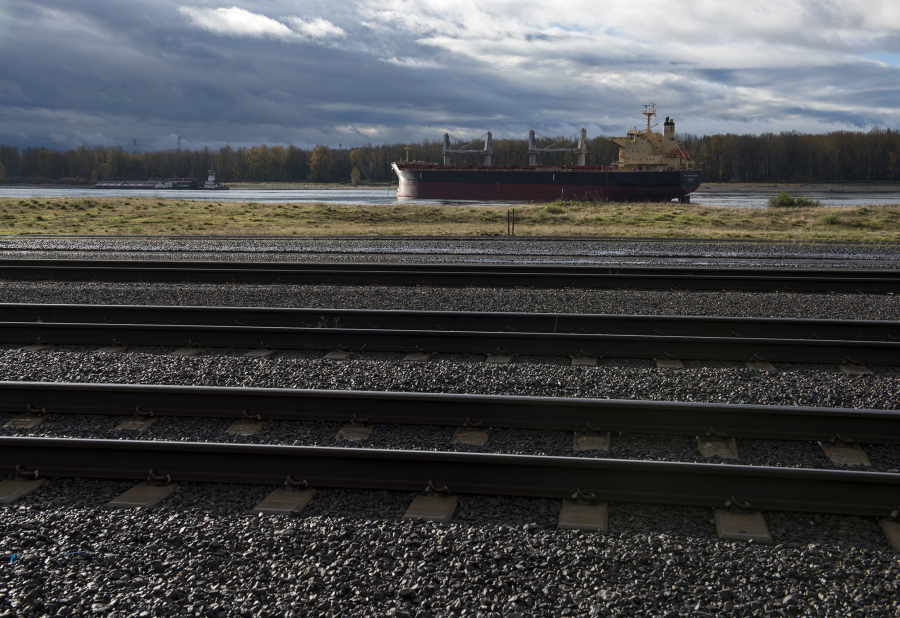The future of Terminal 5, the proposed home for the crude-by-rail terminal, appears to be back at square one. The Port of Vancouver has spent eight years and hundreds of millions of dollars turning the property into prized industrial land and still awaits its first tenant.
So where does the port of possibility go from here?
Where it won’t go seems clear — no fossil fuels — as long as this board of commissioners is around, said outgoing commissioner Brian Wolfe.
“The passion that group has, it’s just not going to happen,” he said.
In the loop
Today, Terminal 5 is a gritty expanse of land next to the Columbia River at the most downstream point of port property. It is home only to mounds of dirt, trucks, and looping railroad tracks.
Port staff see this terminal as a game-changer. At its full potential, the 100-acre parcel could be home to global importers and exporters who could ramp up port revenues and generate work for dozens of new laborers, they said.
Growth like that doesn’t come without a hefty investment of time and money, though.
The Port of Vancouver spent $48.25 million to buy the property in 2009. Then it became the linchpin of the port’s $275 million West Vancouver Freight Access Project, which carved out new access and added 40 miles of track to streamline shipping in and out of the port.
“It’s like adding lanes to a freeway,” Port of Vancouver spokeswoman Abbi Russell said.
A big part of those investments went into creating the rail loops, which can accommodate four 8,500-foot unit trains hauling dry or liquid bulk cargoes. At full capacity, the number of railcars could rise from 60,000 a year to 400,000. Each would pay fees and ring up port revenues.
“We charge on the throughput of every metric ton of cargo that goes through,” said Alastair Smith, the port’s chief of marketing and sales. “All of those fees add up and multiply, and that’s what makes the revenue go up dramatically.”
Dry cargoes could include potash, clays, grains and metals. Liquid cargo would likely include a fuel or chemicals like methanol.
Geographically speaking, Vancouver Energy would have had a relatively small footprint at Terminal 5. Its plans mostly consisted of an unloading rack that straddled the railroad and a system for draining the crude oil and piping it into storage tanks a few hundred yards away for transfer into tanker ships.
The terminal’s 22-acre site of storage tanks would have been along Northwest Lower River Road, next to Farwest Steel, and it could house a similar industrial tenant.
More than 80 acres of real estate are available inside the loop, but the key will be landing the right tenants. Multiple tenants could site there, but the loops would be best used with unit trains that carry one kind of cargo rather than a mishmash.
One recent example was BHP Billiton, the giant Australian mining company. Until 2014, it planned to build a large facility to export tons of potash used in crop fertilizers. At its highest gear, it would have moved 8 million metric tons through the port.
“That’s the kind of opportunity that would be ideal,” Smith said.
For comparison, United Grain, the port’s largest tenant by cargo load, moved 5.38 million metric tons in 2016.
But BHP Billiton’s struggles in negotiating with BNSF Railway, which owns connecting railroads, and the decline of potash values led to a break in the deal.
Finding a tenant who can be a high-volume supplier isn’t something that’s going to happen overnight, Smith said.
“These are not just things you buy off the shelf.”
Hot commodities
The Port of Vancouver, then, is in the market for new tenants. Last November, it began accepting statements of interest from companies.
According to Russell, the port received sufficient interest to extend its deadline to receive those statements by another month.
“We received several SOIs, a few of which we’re still discussing,” she said in an email.
Smith, who leads the hunt for a tenant for Terminal 5, declined to say which companies or commodities are in play. The site could be used for importing and exporting automobiles and windmills, but bulk cargo would make sense considering the investments in rail, said Wolfe.
If the right tenant fit inside a Venn diagram, it would have overlapping values of meeting voters’ environmental standards, use the rail systems and be a valuable commodity. Those aren’t easy to find, Wolfe said.
“I wish we could bring unit trains full of solar panels or maybe export them out, but I don’t think there’s anything like that on the threshold,” he said. “There are several folks out there shaking the bushes trying to find a commodity.”
Smith’s team of salespeople are the ones pursuing the tenants. The sales and marketing department has roughly 10 employees who do everything from analyze market trends to making sales calls to large companies. Smith said some salespeople are on the road 130 days a year.
At this point, Smith said, they are looking for anything that pencils out. The port could generate revenue through fees on high volumes of cargo, or it could sign a profitable lease.
“In my mind, I always said we would never give up the waterfront for less than 3 million tons per year” in cargo, he said. “But if someone comes in and said we’d give you 1 million tons, but we’d pay you three times as much, the Scotsman in me would probably say ‘Hey, that’s all right.’ ”
One offer so far has been to handle cargo in 500,000 tons per year, which was rebuffed, Smith said.
“This is a very, very valuable asset,” he said. “You tie up your most valuable asset in a low volume, that doesn’t make sense. Sometimes you’re better waiting a bit longer to get the right opportunity.”
While the right opportunity probably won’t include coal or crude oil, Smith said, it doesn’t mean the port won’t look into other energy commodities.
“There’s revenue in energy but it just depends on what the commission’s policy is going to be as to as which energy they will accept,” he said.




